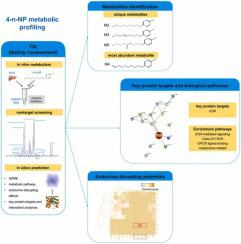Journal of Hazardous Materials ( IF 12.2 ) Pub Date : 2023-01-20 , DOI: 10.1016/j.jhazmat.2023.130830 Ruili Xie 1 , Yiping Xu 2 , Mei Ma 1 , Xiaodan Wang 3 , Lei Zhang 3 , Zijian Wang 4

|
4-n-nonylphenol (4-n-NP), a typical endocrine disrupting chemical, has been so far frequently detected in various environmental mediums and editable food. However, the specific metabolic pathways in human and potential adverse effects of metabolites have not been elucidated yet. Here, metabolic profiling of 4-n-NP in human liver microsome (HLM) was comprehensively characterized by integrated approaches of testing and assessment. A total of 21 metabolites were identified using nontarget analysis with high-resolution mass spectrum, including three groups of unique phase I metabolites first determined in HLM. Seven various metabolic pathways of 4-n-NP were identified by both in silico and in vitro, and CYP1A2, 2C19, and 2D6 were the mainly participating enzymes. Two secondary metabolites with carbonyl groups on side chains (M4, M7) presented most abundant in HLM, which were also predicted to have high binding affinities towards HPG-axis-related receptors (AR, ER, and PR). ESRs (estrogen receptors) were shared core protein targets for all metabolites revealed by protein-protein interaction networks. Biological functions enrichment analysis indicated that 4-n-NP metabolites might primarily involve in ESR-mediated signaling, GPCR ligand binding, Class A/1 (Rhodopsin-like receptors) and metabolism-related pathways. These findings of 4-n-NP metabolites, pathways, and biological effects provide insightful information for its environmental exposure and risk assessment.
中文翻译:

通过综合测试和评估方法对人肝微粒体中的 4-n-壬基苯酚进行首次代谢分析:代谢物、途径和生物学效应
4-n-壬基苯酚 (4-n-NP) 是一种典型的内分泌干扰化学物质,迄今为止经常在各种环境介质和可编辑食品中检测到。然而,尚未阐明其在人体中的具体代谢途径和代谢物的潜在不良影响。在这里,人肝微粒体 (HLM) 中 4-n-NP 的代谢谱通过综合测试和评估方法进行了全面表征。使用具有高分辨率质谱的非目标分析共鉴定了 21 种代谢物,包括三组首先在 HLM 中确定的独特 I 期代谢物。通过计算机和体外鉴定了 4-n-NP 的 7 种不同代谢途径,CYP1A2、2C19 和 2D6 是主要参与酶。侧链上带有羰基的两种次级代谢产物(M4,M7) 在 HLM 中含量最高,预计其对 HPG 轴相关受体(AR、ER 和 PR)具有高结合亲和力。ESR(雌激素受体)是蛋白质-蛋白质相互作用网络揭示的所有代谢物的共享核心蛋白质靶标。生物学功能富集分析表明,4-n-NP 代谢物可能主要参与 ESR 介导的信号传导、GPCR 配体结合、A/1 类(类视紫红质受体)和代谢相关通路。4-n-NP 代谢物、途径和生物效应的这些发现为其环境暴露和风险评估提供了有见地的信息。ESR(雌激素受体)是蛋白质-蛋白质相互作用网络揭示的所有代谢物的共享核心蛋白质靶标。生物学功能富集分析表明,4-n-NP 代谢物可能主要参与 ESR 介导的信号传导、GPCR 配体结合、A/1 类(类视紫红质受体)和代谢相关通路。4-n-NP 代谢物、途径和生物效应的这些发现为其环境暴露和风险评估提供了有见地的信息。ESR(雌激素受体)是蛋白质-蛋白质相互作用网络揭示的所有代谢物的共享核心蛋白质靶标。生物学功能富集分析表明,4-n-NP 代谢物可能主要参与 ESR 介导的信号传导、GPCR 配体结合、A/1 类(类视紫红质受体)和代谢相关通路。4-n-NP 代谢物、途径和生物效应的这些发现为其环境暴露和风险评估提供了有见地的信息。































 京公网安备 11010802027423号
京公网安备 11010802027423号